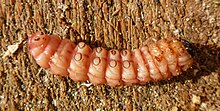Willow Borer
| Willow Borer | ||||||||||||
|---|---|---|---|---|---|---|---|---|---|---|---|---|

Willow Borer ( Cossus cossus ) |
||||||||||||
| Systematics | ||||||||||||
|
||||||||||||
| Scientific name | ||||||||||||
| Cossus cossus | ||||||||||||
| ( Linnaeus , 1758) |

The Weidenbohrer ( Cossus cossus ) is a butterfly ( moth ) from the family of the wood drill (Cossidae).
features
The moths reach a wingspan of 65 to 80 millimeters and have a plump build, with the females being thicker and larger than the males. They have light gray wings on which a dark gray marbling or lines are drawn. In addition, parts of the wings are brownish in color. The color imitates tree bark. They have only rudimentary proboscis , so they can not feed.
The caterpillars are about 100 millimeters long and have a broad dark red colored back and otherwise a yellow body. Her head and part of the neck plate are colored black. They have isolated, short white hair and the body is very shiny.
Occurrence
The moths can be found where old willows stand, i.e. by flowing water, on meadows, in parks or, rarely, in mixed forests. The distribution area extends over Europe , the north of Africa and the temperate zones of Asia . In the Alps they occur up to an altitude of 1500 m . They are common and common.
Way of life
Flight and caterpillar times
The nocturnal moths fly from late May to early August, the caterpillar overwinters two to four times.
Food of the caterpillars
The caterpillars feed on various deciduous trees, but have a preference for goat willow ( Salix caprea ) and other willow , silver birch ( Betula pendula ), alder ( Alnus glutinosa ), pear ( Pyrus communis ) and apple ( Malus domestica ).
development
After mating, the females lay their eggs individually or in small groups in crevices of the bark. As a rule, weakened or already dead trees are preferred. After hatching, the caterpillars eat and live in the bark of the trees until they have shed their skin several times. Later they penetrate deeper into the wood, which they pass through with their corridors from top to bottom. These have an oval cross-section and are up to two centimeters wide. As a result of eating, the trees can die, this is particularly the case when there are several caterpillars. Older caterpillars have a strong smell of vinegar , you can smell this smell around the infested plant. Their development is complete after two to four years. The pupation can be done in different ways. Either the caterpillar leaves its tree in autumn, digs into the ground and pupates after wintering, or it overwinters in the tree and digs into the ground after wintering. It also happens that at the end of its feeding passage in the wood, it pupates in a cocoon about six centimeters in size made from thread and wood chips.
swell
Individual evidence
- ↑ a b c Heiko Bellmann : The new Kosmos butterfly guide. Butterflies, caterpillars and forage plants. Franckh-Kosmos, Stuttgart 2003, ISBN 3-440-09330-1 , p. 62.
- ↑ Manfred Koch : We identify butterflies. Volume 2: Bears, Spinners, Swarmers and Drills in Germany. 2nd, expanded edition. Neumann, Radebeul / Berlin 1964, DNB 452481929 .
literature
- Günter Ebert, Thomas Esche, Rene Herrmann, Axel Hofmann, Hans Georg Lussi, Ingo Nikusch, Wolfgang Speidel, Axel Steiner, Jürgen Thiele: Moth I (root borer (Hepialidae), wood borer (Cossidae), ram (Zygaenidae), snail moth (Limacodidae)) , Sack carriers (Psychidae), window stains (Thyrididae)) . In: The butterflies of Baden-Württemberg . tape 3 . Ulmer Verlag, Stuttgart 1993, ISBN 3-8001-3472-1 .


